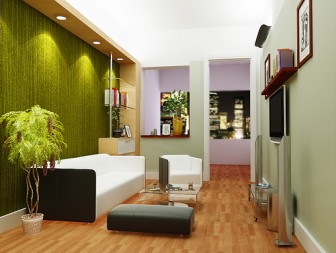The placement of furniture dictates a bedroom’s flow of traffic and defines sleeping, dressing, and conversation areas. It helps determine whether the room has a snug, secluded feel or an open, airy one. Warm colors, plush textures, and casual clutter make a room seem more intimate, while pale colors, sleek surfaces, and minimal styling make even the smallest room seem spacious.
Lighting has a powerful effect on our perception of space. Fluorescent bulbs cast a cool and contemporary light; incandescent lamps give off a warm glow. Bright light, especially natural light, makes a room seem more open, while candlelight creates a sense of intimacy and drama.
Large bedrooms demand a different approach, especially if your aspirations include a sense of intimacy. Start by delineating discrete areas with an arrangement of sofas, chaise longues, or easy chairs. Define a reading nook or dressing space with an area rug in a rich tone. Pull your bed out from the wall, and drape it in layers of fabric.
Whatever the size of your bedroom, little touches count for a lot. Flowers on the night table scent the air. A plush rug eases the cold on winter nights. A chenille throw folded at the foot of the bed invites an afternoon nap. It’s not a showcase you’re creating, but a personal haven. Make it inviting, make it soothing, make it yours.
 To underscore a gorgeous window treatment, try to install downlights in the ceilingâ€â€a bigger project (involving electrical work and, sometimes, plastering) than you may desire. The low-budget version? Plant an uplight, available at any lighting store, at the foot of the draperies, concealing the fixture behind a piece of furniture. This looks especially good with sheers, though be aware that outsiders can see through lighted sheers at night. (Translation: Restrict this effect to the living room.)
To underscore a gorgeous window treatment, try to install downlights in the ceilingâ€â€a bigger project (involving electrical work and, sometimes, plastering) than you may desire. The low-budget version? Plant an uplight, available at any lighting store, at the foot of the draperies, concealing the fixture behind a piece of furniture. This looks especially good with sheers, though be aware that outsiders can see through lighted sheers at night. (Translation: Restrict this effect to the living room.)
 In a small space, the right plan can artfully incorporate more furnishings than you might expect. Stacked white storage cubes draw attention upward and make an under-eave space appear taller, while providing ample room to store clothing. Camp furnishings, such as folding tables and chairs, are flexible and have a slimmer profile than indoor items. A secretary serves as both desk and nightstand, and closes to hide clutter. A restored steamer trunk offers seating and storage. Anything that can serve more than one purpose is especially welcome in a small space. Much of this room’s special appeal derives from its surprising structure, hut you could easily replicate its visual punch in an attic room or loft.
In a small space, the right plan can artfully incorporate more furnishings than you might expect. Stacked white storage cubes draw attention upward and make an under-eave space appear taller, while providing ample room to store clothing. Camp furnishings, such as folding tables and chairs, are flexible and have a slimmer profile than indoor items. A secretary serves as both desk and nightstand, and closes to hide clutter. A restored steamer trunk offers seating and storage. Anything that can serve more than one purpose is especially welcome in a small space. Much of this room’s special appeal derives from its surprising structure, hut you could easily replicate its visual punch in an attic room or loft.